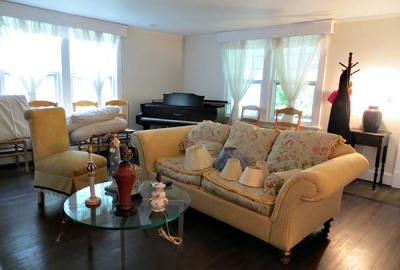Guild Hall’s Home for the Arts

Guild Hall has extended its footprint, annexing a lot to its south to provide housing for performers and, potentially, artist residencies.
The house, on Dunemere Lane in East Hampton Village, provided lodging for many of the headliners and supporting players from last summer’s lineup. This year, the cultural center anticipates that it will house such performers as Linda Lavin, Carol Kane, Mavis Staples, and the Spin Doctors, as well as the wardrobe and stage management team from the June production of “All My Sons.” Several KidsFest performers and members of the Big Apple Circus will use the space as well as the season goes by.
The five-bedroom, two-and-a-half bath residence, now christened Guild House, was purchased last year from David and Kate Epstein, who raised their family in the house and were ready to sell it after 30 years. Buying it “seemed like a no-brainer, something so obvious you just have to go for it, an investment in the future,” said Ruth Appelhof, Guild Hall’s executive director, over lunch at the house’s farm table on Friday.
Marty Cohen had just taken the chairman’s seat on the Guild Hall board. In a statement, he called the opportunity, “once in a lifetime‚” and a compelling purchase. He was not the only one. The house, with its $2.7 million asking price, ended up, Ms. Appelhof said, with “resounding approval from the board. We’re all thrilled to have it.”
While the immediate benefits are the savings on rent for performers who need a place to stay, a more exciting future use is envisioned as a home to artists-in-residence. According to Ms. Appelhof, it was Jon Robin Baitz, best known for his plays but also a screenwriter, producer, actor, and professor at Stony Brook Southampton, who introduced the idea. During his acceptance speech for the Guild Hall Academy of the Arts lifetime achievement award a few years back, he told those assembled that it was their responsibility to attract younger people back to the community and continue the art colony that had brought them here in the first place.
“He spoke so eloquently,” said Ms. Appelhof. “I began to see this effort as an extension of his words, to bring young people out, for the run of a play in the summer or a full winter residency.” Since then and after purchasing the house, Guild Hall has been investigating the options, working with programs in the United States and abroad to develop something that would best suit the institution and the area.
Research showed that each residency has something that sets it apart from the others. “The thing we have here is the wonderful pool of talent in East Hampton and the area surrounding it, the writers, painters, musicians, and actors, who would make great mentors,” Ms. Appelhof said.
The building, which is in a residential district, can only accommodate four unrelated people at a time under the zoning code. (Guild Hall is adhering strictly to the code, leaving one bedroom empty.) Plans so far include a room for a program administrator, who would live in the house during the length of the residencies, and three rooms for artists working in the very disciplines Guild Hall recognizes in its Academy of the Arts awards: visual, literary, and performance. Such a dynamic, said Ms. Appelhof, should encourage cross-discipline approaches and could be further developed with mentors.
Mr. Baitz, demonstrating his own commitment, is now a member of a committee working on the program’s development. Other members include the composer and conductor Victoria Bond and the visual artist Eric Fischl, who is a recent addition to the Guild Hall board.
Of course, there is an issue of money. The property was purchased under a mortgage and the board is still raising money to defray those expenses. Board members have donated “gently used” furniture and household items, and Peter-Tolin Baker, a designer of event and retail spaces who has done set design locally, has volunteered his services to put it all together.
Already, there is a baby grand piano in the living room, where Ms. Bond gave an impromptu concert at a recent committee meeting, an opportune meeting of environment and event. “Can’t you see a drawing class taking place outside on the lawn or actors running their lines on the front porch?” asked Ms. Appelhof during a tour of the house.
And you can, very much indeed.
